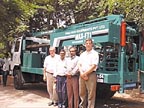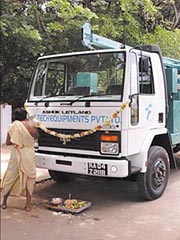

India is about a third of the size of the United States. However, it houses one billion people, nearly four times the amount in America. There are 23 states that comprise the country, and we stayed in the city of Bangalore, the capital of Karnataka state. The rock is much the same as it is here in the United States, mostly granite, marble, limestone and sandstone, with granite being the most abundant. It seemed that everything was made of granite - fence posts, drain covers, house walls - if it's wood over here, it's granite over there.
Believe it or not, we were told that there are over 12,000 air rotary drills (all made in country, including the high-pressure compressors) in the country, drilling almost 25,000 wells a day. They drill 24 hours a day, seven days a week. The problem is it takes five to six wells to find one that produces anything sufficient enough to use. They also informed us that their rules stipulate 4 to 5 gpm for a residential well, and at least 20 gpm for an agricultural well. Another problem is the fact that India, like the United States, is actually taking more water out of the ground than is being recharged. As a result of these problems, there are laws being passed in many of the states banning un-permitted drilling. Until now, if you wanted to drill a well, you set up your rig and drilled a well. Now a permit is needed in at least a half dozen of the states, with many more to follow.

Our goal was to introduce the Hydro-Frac technology on a commercial basis and provide technical support to the drillers. The main reason we needed to set up shop over there is because it is so cost prohibitive to import - you have to pay a 60 percent duty on anything imported, which would obviously drive the cost of the equipment out of the average driller's price range. What my father did was spend the last three years meeting with officials and locals in the hope of starting a business relationship with these people, ultimately making it possible to do business in country. The task was not at all as easy as it seems.
First a relationship had to be made with a local manufacturer, then approval from the government must be granted (for this we enlisted the aid of a U.S.-based Indian agent) and finally the technology must be proven. It took three years to get past the first two steps and to a point where we could introduce the first two demo units. Which brings us to the reason for the trip.

The demo unit was almost complete when we arrived; just a few small modifications were necessary. Ganesh and Shankar managed to put together a very good machine. Then it had be properly blessed by a Hindu priest. The local custom is to have all new pieces of equipment blessed before being put into service.
Now that the demo unit had been completed, it was time to test it. The first job we did was in the village of Hescargata - the well was 450 feet deep with 14 feet of casing. The first thing we did was camera log the well. We noticed a lot of unconsolidated areas until we reached about 70 feet, so we decided to set the packer at 75 feet. We had a maximum pressure of 1,200 psi, dropping off quickly to 800 psi, then slowly to 400 psi. We used a total of 2,000 gallons. We saw similar readings on the next well, but on the third we saw very low pressures, maximum 200 psi, and the pressure never dropped at all. However, we saw lots of color on the discharge, which is one of the signs we look for.
All in all, we did four jobs while there, and they have since completed more than another dozen or so. The results have shown that they all work (I will pass the exact numbers on to you as soon as I receive them), and the government is very happy with what they have seen. Now it's time to get the second rig running and catch the drillers' interest. And now that we have finalized our partnership with Ganesh and Shankar, we are proud to introduce our newest business venture, Frac-Tech Equipments PVT. LTD, based in Bangalore, India.
Report Abusive Comment